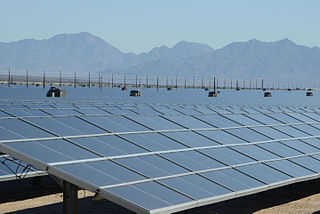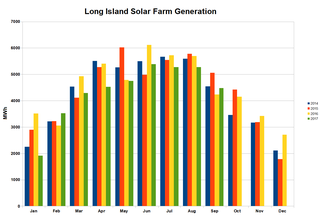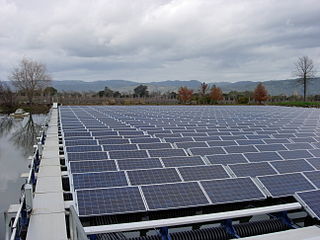
Solar energy is radiant light and heat from the Sun that is harnessed using a range of technologies such as solar power to generate electricity, solar thermal energy, and solar architecture. It is an essential source of renewable energy, and its technologies are broadly characterized as either passive solar or active solar depending on how they capture and distribute solar energy or convert it into solar power. Active solar techniques include the use of photovoltaic systems, concentrated solar power, and solar water heating to harness the energy. Passive solar techniques include orienting a building to the Sun, selecting materials with favorable thermal mass or light-dispersing properties, and designing spaces that naturally circulate air.

Kyocera Corporation is a Japanese multinational ceramics and electronics manufacturer headquartered in Kyoto, Japan. It was founded as Kyoto Ceramic Company, Limited in 1959 by Kazuo Inamori and renamed in 1982. It manufactures industrial ceramics, solar power generating systems, telecommunications equipment, office document imaging equipment, electronic components, semiconductor packages, cutting tools, and components for medical and dental implant systems.

Many countries and territories have installed significant solar power capacity into their electrical grids to supplement or provide an alternative to conventional energy sources. Solar power plants use one of two technologies:
Abengoa Solar is a subsidiary of Abengoa. Its primary activities include designing, promotion, financing attainment, construction and operation of solar power stations that use photovoltaics, concentrated photovoltaics, or concentrated solar thermal technologies.

Spain is one of the first countries to deploy large-scale solar photovoltaics, and is the world leader in concentrated solar power (CSP) production.

The Monte Alto photovoltaic power plant in Spain has a generating capacity of 9.55 megawatts peak (MWp) and will generate 14 million kilowatt-hours of electricity per annum. It cost 65 million euros [US$87 million].
Guadarranque solar power plant is a photovoltaic solar power plant in the Guadarranque industrial park in San Roque, Cádiz, Spain. The plant is owned and operated by Endesa.
Beneixama photovoltaic power plant is a 20 MW photovoltaic power plant located in Beneixama, Spain. The plant consists of approximately 100,000 solar panels, encompassing an area of approximately 500,000 m2. The panels are City Solar PQ 200 modules made of polycrystalline silicon solar cells. In addition, 200 units of Siemens photovoltaic inverters "Sinvert Solar 100 Master" were installed.
A photovoltaic system, also PV system or solar power system, is an electric power system designed to supply usable solar power by means of photovoltaics. It consists of an arrangement of several components, including solar panels to absorb and convert sunlight into electricity, a solar inverter to convert the output from direct to alternating current, as well as mounting, cabling, and other electrical accessories to set up a working system. It may also use a solar tracking system to improve the system's overall performance and include an integrated battery.

The PS20 solar power plant (PS20) solar power plant is a solar thermal energy plant in Sanlucar la Mayor near Seville in Andalusia, Spain. It was the world's most powerful solar power tower until the Ivanpah Solar Power Facility in California became operational in 2014. The 20 megawatt (MW) solar power tower produces electricity with large movable mirrors called heliostats.
The Olmedilla Photovoltaic Park is a 60-megawatt (MW) photovoltaic power plant, located in Olmedilla de Alarcón, Spain. When completed in July 2008, it was the world's largest power plant using photovoltaic technology.
The Dulcinea Solar Plant is a photovoltaic power station in Cuenca, Spain. It consists of 300 photovoltaic generating units with a total capacity of 31.8 MW. The solar power station covers area of 230,324 m2 (2,479,186.9 sq ft). It is equipped with 82,896 Kyocera KC-200-GHT2 photovoltaic modules, 6,078 Kyocera KD-210-GHP2 modules, and 66,286 Suntech STP-210/18Ud modules. 6,600 strings of 24 photovoltaic panels linked in series 300 SMA SC100-Outdoor solar inverters. The estimated available radiation of 1,810 kWh/m2 per year is 1,497 peak sunlight hours.
The Arnedo Solar Plant is a solar photovoltaic power plant located in Arnedo, La Rioja, Spain. The power system installations are supplied and the solar plant is operated by T-Solar. The plant was built by Isolux Corsán in 2008. It cost €181 million.

The Space Coast Next Generation Solar Energy Center is a 10 megawatt (MW) solar photovoltaic (PV) facility at the Kennedy Space Center, Florida. Commissioned in April 2010, the center is the result of a partnership between NASA and Florida Power & Light. The facility has approximately 35,000 solar photovoltaic panels from SunPower covering an area of 60 acres. The facility provides slightly less than one percent of the power needed to keep Kennedy Space Center up and running.

The Desert Sunlight Solar Farm is a 550-megawatt (MWAC) photovoltaic power station approximately six miles north of Desert Center, California, United States, in the Mojave Desert. It uses approximately 8.8 million cadmium telluride modules made by the US thin-film manufacturer First Solar. As of Fall 2015, the Solar Farm has the same 550 MW installed capacity as the Topaz Solar Farm in the Carrizo Plain region of Central California, making both of them tied for the second largest completed solar plants by installed capacity.

The 32 megawatt AC Long Island Solar Farm (LISF), located in Upton, New York, was the largest photovoltaic array in the eastern U.S. in November 2011. The LISF is made up of 164,312 solar panels from BP Solar which provide enough electricity for roughly 4,500 households. The project will cause the abatement of more than 30,000 metric tons of carbon dioxide emissions per year. LISF is co-owned by BP Solar and MetLife through Long Island Solar Farm LLC. Municipal utility Long Island Power Authority (LIPA) buys the 37-megawatt (49,600 hp) power plant's output, which is estimated at 44 GWh annually, under a 20-year power purchase agreement (PPA). Payments over that time are expected to total $298 million. The project was engineered by Blue Oak Energy and construction subcontracted to Hawkeye LLC from Hauppauge, New York. The plant earned the Best Photovoltaic Project of Year Award from the New York Solar Energy Industries Association. The panels are mounted at a fixed tilt angle of 35°, with the rows spaced approximately 18 ft 4 in (5.59 m) apart.

Solar power in Mexico has the potential to produce vast amounts of energy. 70% of the country has an insolation of greater than 4.5 kWh/m2/day. Using 15% efficient photovoltaics, a square 25 km (16 mi) on each side in the state of Chihuahua or the Sonoran Desert could supply all of Mexico's electricity.

Templin Solar Park is a 128 megawatt (MW) photovoltaic power station, located at the former Templin military airport.
In 2022 Chile produced about 18% of its electricity from solar power, up from 7% in 2018. As of 2022, Chile produces the highest percentage of its electricity from solar in the world. At the end of 2021 Chile was ranked 22nd in the world in terms of installed solar energy.

Floating solar or floating photovoltaics (FPV), sometimes called floatovoltaics, are solar panels mounted on a structure that floats on a body of water, typically a reservoir or a lake such as drinking water reservoirs, quarry lakes, irrigation canals or remediation and tailing ponds. A small number of such systems exist in China,France, India, Japan, South Korea, the United Kingdom, Singapore, and the United States.











